Source: The Conversation (Au and NZ) – By Joanna Mendelssohn, Principal Fellow (Hon), Victorian College of the Arts, University of Melbourne. Editor in Chief, Design and Art of Australia Online, University of Melbourne
Review: Lindy Lee: Moon in a Dew Drop, Museum of Contemporary Art, Sydney.
At a time when the rapidly heating earth seems to put the very future of humanity at risk, in an age when the world appears to be largely governed by clowns, criminals or those who are a combination of both, Lindy Lee’s art soothes the soul, restoring harmony.
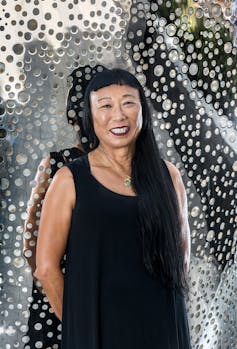
Moon in a Dew Drop, curated by Elizabeth Ann Macgregor, does not show easy patterns or sweet sentiment. Rather it is an expression of tranquillity obtained as the result of hard struggle and rigorous self-examination.
Lee could be described as a typical Australian. She is the child of immigrant refugee parents. Her father came to Australia alone in 1947, before the Communist victory, but her mother was not allowed to follow for some years as our racist immigration policies strictly limited the number of Chinese people allowed to settle here.
Lee became an artist at a time when it was widely assumed that all art was made by men but by an accident of timing her professional career placed her in the vanguard of successful Australian artists who were neither ethnically European or male.In a catalogue essay translated by Fiona He, the Chinese writer Shen Qilan notes that Lee’s art is a continual exploration of “‘Who am I?’ – the first and ultimate philosophical question”.
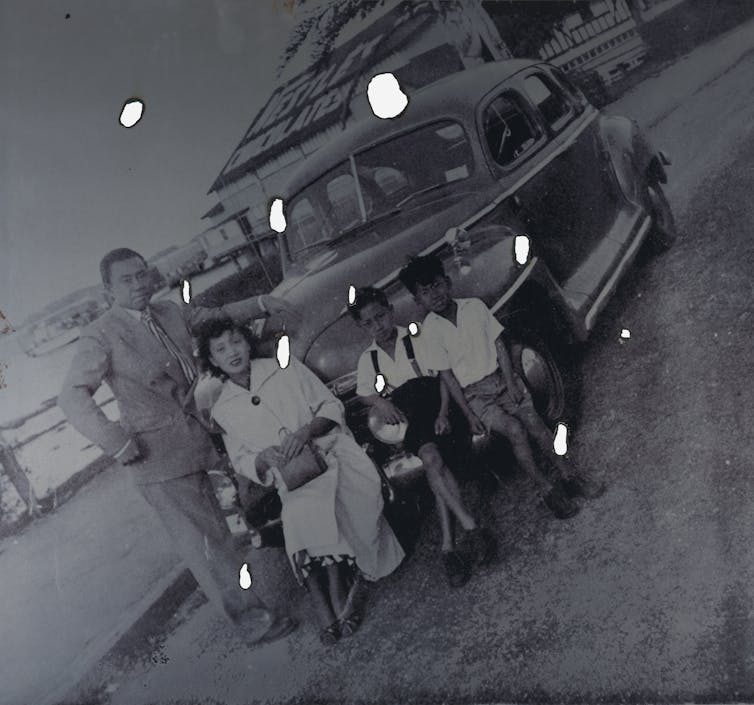
When she was a child, Lee wondered at motes of dust caught in the sunlight. As an adult she is still driven by a sense of wonder in the world around her.
The exhibition arcs over the entire trajectory of Lee’s career, starting with early photocopies of Renaissance and Baroque works. As with most women of her generation, Lee had assumed all great artists were men until she visited Italy and saw the work of Artemisia Gentileschi. Here was an artist who painted women as heroes and whose favourite subject was the Biblical Judith, beheader of Holofernes.
Read more: Explainer: Artemisia Gentileschi, a Baroque heroine for the #MeToo era
After Lee returned to Australia she studied at the Sydney College of the Arts, at first using photocopies as an aide memoir. The process of photocopying entranced her as she began to see these copies as objects in their own right.
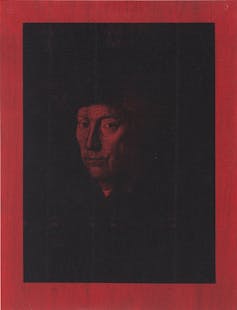
The act of translation through art served as a metaphor for her experience as an Australian with an Asian background, seeing the world at a distance, turning “reality” into something else. From photocopies she turned to black pigmented beeswax, scraping back the European past to create an original present.
Cultural dislocation
In 1985, her painting, White Sacrament, a meditation on an El Greco painting of St Andrew, was purchased for the National Gallery of Australia. Lee was intrigued by the intensity of El Greco’s spirituality and the way this was reflected in his art. Her investigations into spirituality developed in tandem with a sense of cultural dislocation.
As with many Australians born of immigrant parents, Lee did not at first feel a connection to their country or culture. Later she came to understand that her preoccupation with photocopies was also a reflection of seeing herself as a replica, not the real thing, not a part of Australia. It could be argued that all her subsequent art is an exploration of the nature of reality, and a sense of time.
Her 2003 installation, Birth and Death, recreated for this exhibition, comprises 100 red, Chinese accordion books, printed with digitised images of members of her family, past and present, alive and dead. We are all a part of those who go before and who come after.
In 1995, Lee paid her first visit to China and realised that she was neither wholly Chinese nor completely Australian. Instead she continued to draw on both cultures for her understanding of self. The result was her installation, No Up, No Down, I Am the Ten Thousand Things.
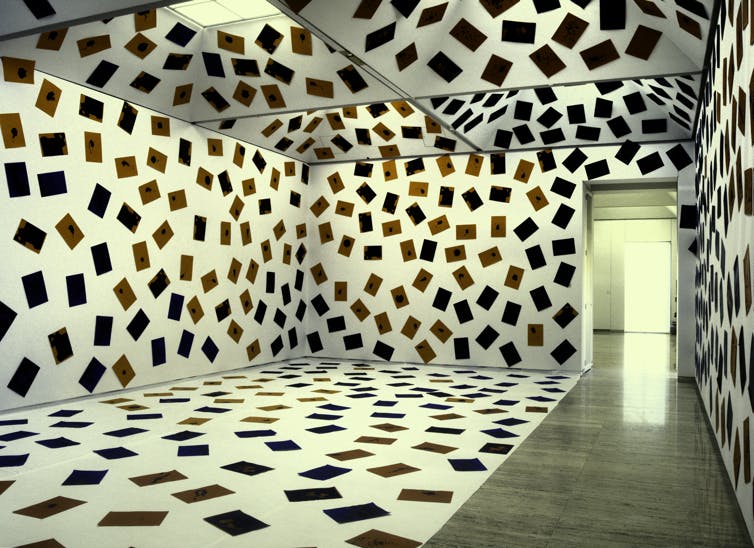
In a catalogue interview with Macgregor she describes this work as the result of being “released from the imprisonment of trying to find my identity as being either Chinese or Anglo or this or that”.
The title is a reference to the Zen philosopher, Dogen who said, “If you want to know your self, forget yourself and be actualised by the 10,000 things.”
In subsequent visits to China, Lee became intrigued by the Daoist tradition of flung ink calligraphy, where the artist allows fate to decide where the pigment falls. In recent years, she has begun to work with the UAP Foundry in Brisbane, making flung pieces out of drops of molten bronze.
The jewel-like fragments look as though they could never be the result of accident, but one of the highlights of the exhibition is the video installation showing Lee almost dancing as she flings down the hot metal as it turns into art.
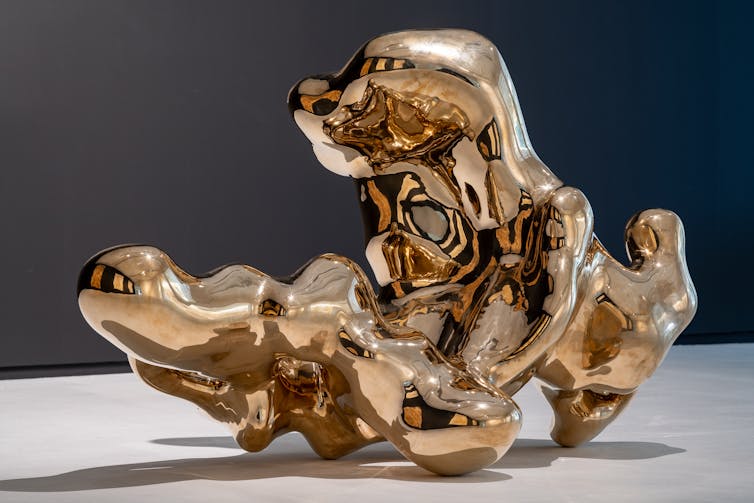
Moonlight Deities, an installation where light shines through multiple, circular holes making entrancing shadow patterns, was made especially for this exhibition, as was the sculpture Secret World of a Starlight Ember.
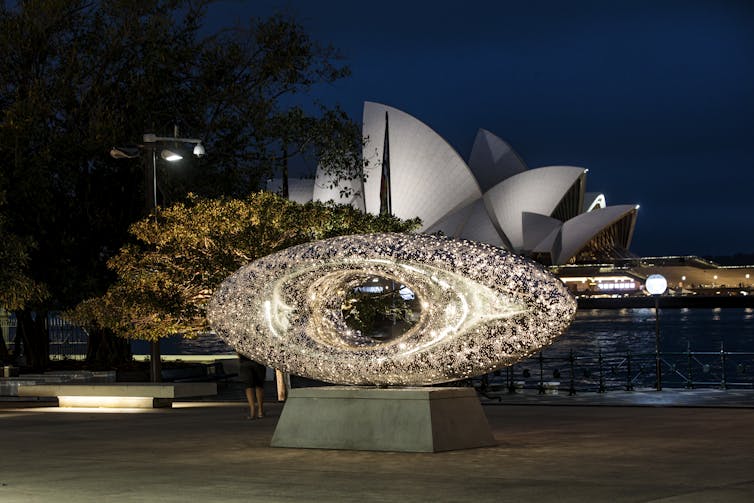
In both works it is easy for the viewer to immerse themselves in the patterns of light, to move with the shadows, to consider themselves as parts of the never ending universe.
This world in which we find ourselves is but a speck in the enormity of the universe, and at the same time a revelation of wonder that we who are so small can be a part of a universe, so large.
Lee tells Macgregor the Buddhist story of the net of Indra, the infinite net, as a metaphor for what she is trying to say through her art.
It’s a Buddhist story. The universe is this infinite net and at each end of the ties of the net there is a jewel. The jewel is perfect and utterly singular, but its perfection, beauty and singularity comes from reflecting every other jewel in the universe.
Lindy Lee: Moon in a Dew Drop is at the Museum of Contemporary Art, Australia until 28 February 2021.
– ref. Lindy Lee’s Moon in a Dew Drop: art driven by a sense of wonder, borne of hard struggle – https://theconversation.com/lindy-lees-moon-in-a-dew-drop-art-driven-by-a-sense-of-wonder-borne-of-hard-struggle-147185








